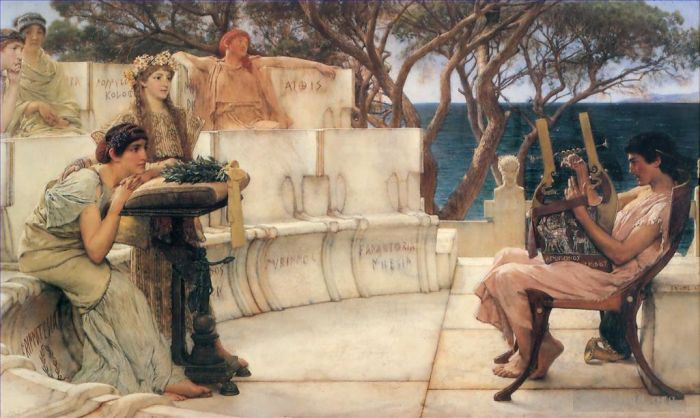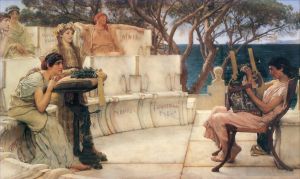Sappho and Alcaeus
Sir Lawrence Alma-Tadema
- Price: Price on Request
- Art Type: Oil Painting
- Size:
- English Comments: 0
- International Comments: 0
- Creating Date:
- Introduction and Works of Sir Lawrence Alma-Tadema >>
Work Overview
- Sappho and Alcaeus
Sir Lawrence Alma-Tadema
Date: 1881
Style: Romanticism
Genre: history painting
Media: oil, canvas
Dimensions: 122 x 66 cm
Location: Walters Art Museum, Baltimore, MD, US
Sappho and Alcaeus is an 1881 oil painting by Lawrence Alma-Tadema. It is held by the Walters Art Museum in Baltimore.
The painting measures 66 by 122 centimetres (26 in × 48 in). It depicts a concert in the late 7th century BC, with the poet Alcaeus of Mytilene playing the kithara. In the audience is fellow Lesbian poet Sappho, accompanied by several of her female friends. Sappho is playing close attention to the performance, resting her arm on a cushion which bears a laurel wreath, presumably intended for the performer. The painting illustrates a passage by the poet Hermesianax, recorded by Athenaeus in his Deipnosophistae ("The Philosophers' Banquet"), book 13, page 598.
The location, with tiers of white marble seating, is based on the Theatre of Dionysus in Athens, but Alma-Tadema has replaced the original inscribed names of Athenians with the names of Sappho's friends. In the background, the Aegean Sea can be seen some trees.
The painting was exhibited at the Royal Academy in 1881, and depicted in William Powell Frith's A Private View at the Royal Academy, 1881, to the far right, being inspected byJohn Everett Millais. It was highly praised by critics: Punch described it as "marbellous". It was acquired by William Thompson Walters of Baltimore, and on his death in 1894 it was inherited by his son Henry Walters, who left it to the Walters Art Museum on his own death in 1931.
In 1870, the Dutch-born, Belgian-trained artist Alma-Tadema moved to London, where he found a ready market among the wealthy middle classes for paintings re-creating scenes of domestic life in imperial Roman times. In this work, however, he turns to early Greece to illustrate a passage by the ancient Greek poet Hermesianax (active ca. 330 BC) preserved in Atheneaus, Deipnosophistae, "Banquet of the Learned," book 2, line 598. On the island of Lesbos (Mytilene), in the late 7th century BC, Sappho and her companions listen rapturously as the poet Alcaeus plays a "kithara." Striving for verisimilitude, Alma-Tadema copied the marble seating of the Theater of Dionysos in Athens, although he substituted the names of members of Sappho's sorority for those of the officials incised on the Athenian prototype.
In 1870, the Dutch-born, Belgian-trained artist Alma-Tadema moved to London, where he found a ready market among the wealthy middle classes for paintings re-creating scenes of domestic life in imperial Roman times. In this work, however, he turns to early Greece to illustrate a passage by the ancient Greek poet Hermesianax (active ca. 330 BC) preserved in Atheneaus, Deipnosophistae, "Banquet of the Learned," book 2, line 598. On the island of Lesbos (Mytilene), in the late 7th century BC, Sappho and her companions listen rapturously as the poet Alcaeus plays a "kithara." Striving for verisimilitude, Alma-Tadema copied the marble seating of the Theater of Dionysos in Athens, although he substituted the names of members of Sappho's sorority for those of the officials incised on the Athenian prototype.
- Copyright Statement:
All the reproduction of any forms about this work unauthorized by Singing Palette including images, texts and so on will be deemed to be violating the Copyright Laws.
To cite this webpage, please link back here.
- >> English Comments
- >> Chinese Comments
- >> French Comments
- >> German Comments
- >>Report
- Death of the Pharaohs Firstborn Son
- A Pyrrhic Dance
- Summer Offering Young Girl with Roses
- Between Venus and Bacchus
- A Roman Emperor AD41detail1
- Portrait of Ignacy Jan Paderewski
- Portrait Of Mrs Charles Wyllie
- The Massacre of the Monks of Tamond
- Pandora
- Who is it
- Egyptian juggler
- A Family Group
- The Death of Hippolytus
- A reading from homer detail
- A world of their own
- The Crossing of the River Berizina 1812
- A Hearty Welcome
- In the Temple Opus 1871
- The Flower Market
- A Roman Art Lover2
- The Sculptors Model
- Ask me no more
- In My Studio
- Expectations
- Welcome footsteps
- A Bath An Antique Custom
- A Declaration
- Portrait of a Woman
- Autumn Vintage Festival
- Ave Caesar Io Saturnalia
- Spring Flowers
- Unwelcome Confidences
- The Picture Gallery
- A Roman Emperor
- Boating
- Caracalla and Geta
- The voice of spring
- The Finding of Moses 1904
- Shy
- A votive offering
- A Harvest Festival A Dancing Bacchante at Harvest Time
- Thou Rose of all the Roses
- Portrait of Aime Jules Dalou his Wife and Daughter
- Flora Spring in the Gardens of the Villa Borghese
- The Sculpture Gallery detail
- A Collection of Pictures at the Time of Augustus
- Prose
- A Difference of Opinion
- A Silent Greeting
- Caracalla
- The Potter
- Poetry
- Confidences
- Maria Magdalena
- Golden hour
- Phidias Showing the Frieze of the Parthenon
- A Listner
- Exhausted Maenides after the Dance
- Interrupted
- The Vintage Festival
- Master John Parsons Millet
- A greek woman
- Proclaiming Claudius Emperor
- Flag Of Truce
- Between Hope and Fear
- The Drawing Room at Townshend House
- Venantius Fortunatus Reading His Poems to Radegonda VI
- Portrait Of Miss Laura Theresa Epps
- Strigils and sponges
- Always Welcome
- Drawing Room Holland Park
- Self Portrait
- Pastimes in Ancient Egyupe 300Years Ago
- The Coliseum
- The Roses of Heliogabalus
- Miss Alice Lewis
- Sunshine
- The years at the spring
- Agrippina with the ashes of Germanicus Opus XXXVII
- Interior of Caius Martiuss House
- A reading from homer
- Joseph Overseer of the Pharoahs Granaries
- Tibullus at Delias
- God Speed
- Midday Slumbers
- The Roman Wine Tasters
- Hadrian Visiting a Romano British Pottery
- A Roman Art Lover
- British 18361912A Roman Scribe Writing Dispatches
- On the Road to the Temple of Ceres
- In the Peristyle2
- Faust and Marguerite
- The Baths of Caracalla
- The parting kiss
- Sappho and Alcaeus
- Interior of the Church of San Clemente Rome
- Sculptors in Ancient Rome
- Egyptian Chess Players
- Sir Lawrence From An Absent One
- A Dedication to Bacchus
- Preparation in the Colosseum detail
- Vain Courtship
- Preparation in the Colosseum
- Mrs George Lewis and Her Daughter Elizabeth
- Dolce Far Niente
- Loves Jewelled Fetter
- A Picture Gallery
- When Flowers Return
- Courtship
- A Favourite Custom
- Maurice Sens
- The Favourite Poet
- Tarquinius Superbus
- Unconscious Rivals
- The Sculpture Gallery
- Architecture in Ancient Rome
- Hopeful
- Portrait of the Singer George Henschel
- After the audience
- Cherries
- Sir Lawrence The Soldier Of Marathon
- Hero 1898
- The Triumph of Titus
- A Prize For The Artists Corps
- Antony and Cleopatra
- Ninetyfour in the Shade
- The Education of the Children of Clovis
- The Frigidarium
- Resting
- Silver Favourites
- Entrance to a roman theatre
- Gallo Roman Women
- An exedra
- Sir Lawrence An Audience
- Loves Votaries
- Not at home
- The Siesta
- A sculpture gallery
- A Street Altar
- Pottery painting
- The Discourse
- Courtship the Proposal
- Lawrence Bacchanale 1871
- Under the Roof of Blue Ionian Weather
- Xanthe and Phaon
- Leaving Church in the Fifteenth Century
- Summer Offering
- Water Pets
- A Birth Chamber
- Portrait of Anna Alma Tadema
- In the Tepidarium
- Pleading
- The Soldier of Marathon
- This is our Corner Laurense and Anna Alma Tadema
- Whispering Noon
- Catullus at Lesbias
- The Way to the Temple
- The Honeymoon
- The Conversion Of Paula By Saint Jerome
- An earthly paradise
- Preparations for the Festivities
- Promise of spring
- Comparisons
- An Oleander
- A kiss
- The Family Group
- My Studio
- The Epps Family Screen
- In the Time of Constantine
- Lesbia Weeping over a Sparrow









 Singing Palette
Singing Palette